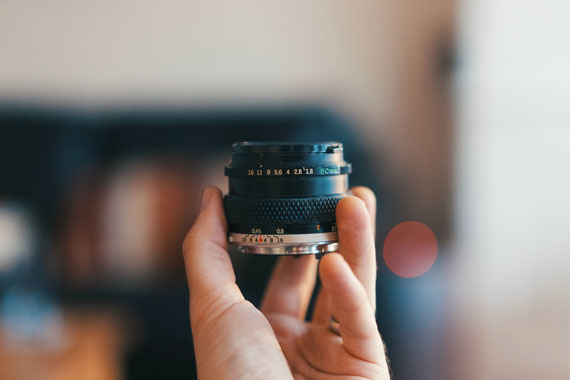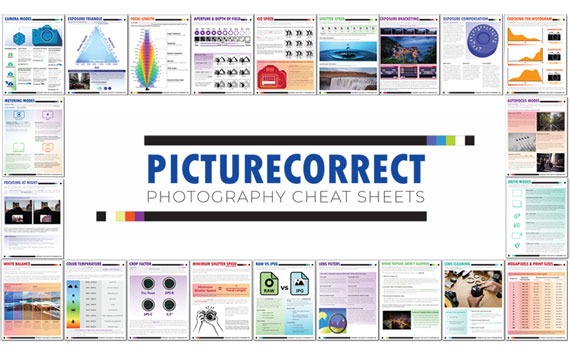Prime lenses, or fixed focal length lenses, can offer a variety of benefits and drawbacks depending on the specific needs and preferences of the photographer. Here’s a list of some of the common pros and cons:
Today’s quick tip comes from the PictureCorrect Fundamental Cheat Sheets which are currently 75% off for a New Year sale that is wrapping up soon.

Photo captured by Al Elmes
Pros of Prime Lenses
Image Quality: Prime lenses are often known for their superior image quality when compared to zoom lenses. They have fewer moving parts and less glass inside, which can lead to sharper images with less distortion.
Low Light Performance: Primes usually have wider maximum apertures (lower f-numbers), which let in more light. This can be a major advantage in low-light situations, and it also allows for more control over depth of field, facilitating beautiful bokeh and background blur.
Weight and Size: Prime lenses are often smaller and lighter than their zoom counterparts. This can be a significant advantage for photographers who need to carry their gear for long periods.
Price: Although there are some very expensive prime lenses, many are surprisingly affordable. Especially for beginners, they can be a cost-effective way to experiment with different focal lengths and aperture settings.
Focus on Composition: Since you cannot adjust the focal length, prime lenses encourage photographers to move around and experiment with composition, which can lead to more creative photos.
Cons of Prime Lenses
Lack of Flexibility: The most significant disadvantage of prime lenses is that they have a fixed focal length, meaning you can’t zoom in or out to adjust your composition. This lack of flexibility can be problematic in certain situations, such as when shooting wildlife, sports, or other types of photography where you can’t always control your distance from the subject.
Need for Multiple Lenses: If you need to shoot at a variety of focal lengths, you’ll need to carry multiple prime lenses. This can add weight to your bag, even though individual primes are generally lighter than zooms.
Changing Lenses: If you’re using primes and need to switch focal lengths frequently, you’ll have to change lenses often. This can be time-consuming and may expose your camera sensor to dust.
Cost: While individual prime lenses can be more affordable than zoom lenses, the cost can add up if you need to buy multiple primes to cover the same focal length range as a single zoom.
Learning Curve: Primes may have a steeper learning curve for beginners who are still getting a handle on composition and the effect of different focal lengths.
As you can see, whether a prime lens or a zoom lens is right for you largely depends on your specific needs, your shooting style, and your budget.
Have you ever wanted to photograph an amazing moment but missed the shot because you didn’t know the right camera settings to use? That’s where some of our most popular camera cheat sheets come in. They are currently 75% off for a New Year sale if you want to check them out.
Whether you’re a seasoned professional or just starting out, photography cheat sheets can be a valuable resource for improving your skills and taking your photography to the next level. The perfect companion for any photographer. Print one out whenever you need it.
Deal ending soon: The Fundamental Camera Cheat Sheets at 75% Off
Like This Article?
Don't Miss The Next One!
Join over 100,000 photographers of all experience levels who receive our free photography tips and articles to stay current:







We do have a few prime lenses, but our work horses are the zoom lenses. There is a huge difference in IQ IMHO after processing in DXO. That is what DXO is famous for. Correcting the flaws in all of the lenses. Sharpness is noticeably improved with out the extreme high cost of some of these lenses.
Try getting a 12-24 mm Canon made or even a 12 mm from Canon. It doesn’t exist. A lot of the complaints can and are corrected in DXO.
Personally I feel the type of lens someone uses is very different depending on what type of photos they like to shoot. I have seldom used my telephoto lens my 100mm macro is on my camera 95% of the time… because I enjoy snapping pictures of spiders and being able to capture the pollen on a flower… the magic of photographing things yours eyes might not see :) but….soon… my new love might be my new fisheye Santa is bringing….anything but the normal for me
I dont’ like fixed lens. I use a 28-85 lens for most of my shots. It is a easy lens to use, and it provides me a lot of opitions. I have fixed lens but I only use when I am shoting at something that is staying in one place. Lens have come a long way since the early 1990’s. Now with SLR Dgital cameras, the need for a fixed lens is no so improtant. Buy a lens that you will comfortable with and take some great shots…
“Another drawback of the prime lens is the price factor. All prime lenses, barring the very basic models, are much more expensive than their zoom counterparts” – This is not always true. Wide angle and normal lenses with fixed focal lengths (14mm – 50mm range) are considerably more affordable than their zoom counterparts with the same f ratio (at least in the case of Nikon).
In the telephoto range it’s much more comfortable and convenient to work with a zoom lens, especially for nature and sports photography, since it’s not always possible to move closer to or farther away from the object, or because the object might move closer to or farther away from the photographer.
The following statement is so very wrong…
“Another drawback of the prime lens is the price factor. All prime lenses, barring the very basic models, are much more expensive than their zoom counterparts.”
Yes, you can get a cheap zoom which doesn’t let much light in (it’s ‘slow’) and therefore isn’t the actual counterpart to the fast prime.
For example, the Canon 50mm f/1.4 costs $400 whereas the 17-55mm f/2.8 costs $1,180. Yeah, maybe if you were going to buy every lens inside that one zoom then, yeah, it would cost more. But, I don’t see many people doing that… instead having two primes to fill the one zoom. So, if you add the Canon 28mm f/1.8 for $510 you’re up to a total of $910 for two *faster* primes (better bokah, better in low light) compared to the slower, yet still fast, zoom for $270 more!
Someone will still mention that you can buy a zoom for 500 bucks… And, yes, a very slow zoom that doesn’t even come close to comparing to a fast prime (lenses that are in the f/3.5-5.6 range).
Sorry… My computer sent the last comment before I was finished.
Third, it is NOT always best to invest in a prime lens. Go for a zoom that fits your needs and employ correct technique (use a tripod, proper aperture, shutter speed etc.)
Now ask me how I know… I was the New England representative for Canon USA for twelve years and have been shooting for the last fifty-two years. I have been using the same three zoom lenses for the past eighteen years… NOT prime lenses, not even “L” series lenses. They are a Canon EF 20-35, Canon EF 28-105 and Canon EF 75-300 IS.
You might want to buy a prime lens for subject matter that you photograph on a constant basis… for example, a high-quality macro lens for shooting bugs.
I defy anyone to look at my images and tell me whether they were shot with a prime lens or a zoom.
I agree with Michael.
In the first place, the difference in quality is REALLY only noticeable on the test bench. I have three zoom lenses which take spectacular images if I shoot properly and judiciously.
In the second place, wide angle lenses which incorporate several focal lengths are known as “wide angle zooms.”
Third, it is NOT
Side note: Even when using a zoom, one should compose a shot by moving around anyhow. A zoom changes the angle of view – there’s no way around it – and that will change the perception of the objects around the subject. The result could be pretty distorted and ugly. So even with a zoom lens, one should pick the focal length for the purpose of angle of view, and then move closer to or farther from the subject (or mvoe around in general) to compose the shot. There is no excuse for laziness in this case, even if you have a good zoom.
I feel I need to weigh in here because I don’t think the discussion is nearly as black and white as one might think it is. I know amateurs that love their prime lenses and I know pros that use Zoom lenses. Fantastic zoom lenses exist and to throw a broad-brush blanket statement along the lines of Prime lenses being the choice of professionals is – to be blunt – irresponsible.
Now I will give you that a wide range zoom lens is not ideal. I have an 18-135mm zoom that is a hefty range to expect any sort of quality out of it. It is the lens i might carry about on family outings (so that I don’t have to change lenses or the like), but it’s not what I use for my professional work. As would be expected for such a range, the sharpness falls off a bit round the edges, and it’s aperture leaves something to be desired.
However, a good tight range – a 24-70mm fixed aperture – is a good lens, and there are three fantastic and popular lenses on the market that are used frequently by professionals: Sigma, Nikon and Canon. They’re not cheap – oh they are not cheap – but they’re all good lenses with a fixed max aperture at f/2.8 (not perfect, but certainly good). They’re sharp all around, and are great zoom lenses.
Now I’m not saying that Zooms are better than Primes, but I don’t want anyone to think that the primes are the only solution. That type of thinking is really pretty dated at this point. Had you made such a comment 5 years ago, i would possibly agree with you. But these days…it’s just not true. You just can’t expect a wide range zoom to be the end-all-be-all.
To that end, any good photographer has in his kit a few important prime lenses. A 35mm, 50mm and the 85mm primes are work horses. But there’s nothing wrong with supplementing with a GOOD zoom lens.
“The resulting images are nothing short of awesome with razor sharpness that is the hallmark of a professional photographer” – absolute poppycock. Image sharpness has nothing to do with a “professional photographer”. A pro, or a real artist, will take a good picture with a crappy camera and lens. There thousands absolutely stunning and classic shots that are not “razor sharp” but are taken just at the right moment in just the right way.